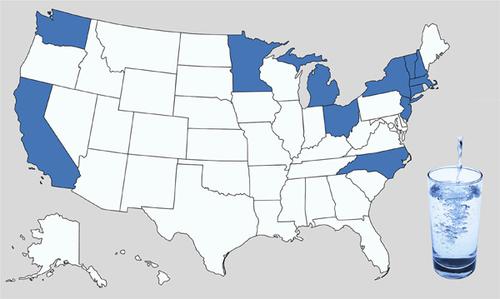当前位置:
X-MOL 学术
›
Environ. Toxicol. Chem.
›
论文详情
Our official English website, www.x-mol.net, welcomes your feedback! (Note: you will need to create a separate account there.)
Recent US State and Federal Drinking Water Guidelines for Per‐ and Polyfluoroalkyl Substances
Environmental Toxicology and Chemistry ( IF 4.1 ) Pub Date : 2020-08-26 , DOI: 10.1002/etc.4863 Gloria B Post 1
Environmental Toxicology and Chemistry ( IF 4.1 ) Pub Date : 2020-08-26 , DOI: 10.1002/etc.4863 Gloria B Post 1
Affiliation

|
Per‐ and polyfluoroalkyl substances (PFAS), a class of synthetic chemicals produced for over 70 years, are of increasing concern because of their widespread environmental presence, extreme persistence, bioaccumulative nature, and evidence for health effects from environmentally relevant exposures. In 2016, the United States Environmental Protection Agency (USEPA) established nonregulatory drinking water Health Advisories of 70 ng/L for individual and total concentrations of perfluorooctanoic acid (PFOA) and perfluorooctane sulfonate (PFOS), the 8‐carbon perfluoroalkyl acids (PFAAs) that are the most thoroughly studied PFAS. As of May 2020, 9 US states had concluded that the USEPA Health Advisories are insufficiently protective and developed more stringent PFOA and PFOS guidelines. In addition, 10 states had developed guidelines for other PFAS, primarily PFAAs. This Critical Review discusses the scientific basis for state and USEPA drinking water guidelines for PFOA and PFOS; the same principles apply to guidelines for other PFAS. Similarities and differences among guidelines arise from both toxicity and exposure considerations. The approximately 4‐fold range among state guidelines (8–35 ng/L for PFOA, 10–40 ng/L for PFOS) is not large or unexpected for guidelines developed by different scientists at different time points, especially when compared with older USEPA and state guidelines that were generally several orders of magnitude higher. Additional state guidelines for PFOA, PFOS, and other PFAS are expected to become available. Environ Toxicol Chem 2021;40:560–563. © 2020 SETAC
中文翻译:

最新的美国州和联邦全氟烷基物质和多氟烷基物质饮用水指南
全氟和多氟烷基物质 (PFAS) 是一类已生产 70 多年的合成化学品,由于其广泛存在于环境中、极端持久性、生物累积性以及环境相关暴露对健康影响的证据,因此越来越受到关注。2016 年,美国环境保护署 (USEPA) 对全氟辛酸 (PFOA) 和全氟辛烷磺酸 (PFOS)、8 碳全氟烷基酸 (PFAA) 的单个和总浓度制定了 70 ng/L 的非监管饮用水健康咨询这是研究最彻底的PFAS。截至 2020 年 5 月,美国 9 个州已得出结论,美国环保署健康建议保护性不足,并制定了更严格的 PFOA 和 PFOS 指南。此外,还有 10 个州为其他 PFAS 制定了指南,主要是PFAAs。这篇批判性评论讨论了州和美国环保局关于全氟辛酸和全氟辛烷磺酸的饮用水指南的科学依据;相同的原则适用于其他 PFAS 的指南。指南之间的异同源于毒性和暴露方面的考虑。各州指南之间的大约 4 倍范围(PFOA 为 8-35 ng/L,PFOS 为 10-40 ng/L)对于不同科学家在不同时间点制定的指南来说并不大或出乎意料,尤其是与较旧的 USEPA 相比时以及通常高出几个数量级的州指导方针。预计将提供有关 PFOA、PFOS 和其他 PFAS 的其他州指南。相同的原则适用于其他 PFAS 的指南。指南之间的异同源于毒性和暴露方面的考虑。各州指南之间的大约 4 倍范围(PFOA 为 8-35 ng/L,PFOS 为 10-40 ng/L)对于不同科学家在不同时间点制定的指南来说并不大或出乎意料,尤其是与较旧的 USEPA 相比时以及通常高出几个数量级的州指导方针。预计将提供有关 PFOA、PFOS 和其他 PFAS 的其他州指南。相同的原则适用于其他 PFAS 的指南。指南之间的异同源于毒性和暴露方面的考虑。各州指南之间的大约 4 倍范围(PFOA 为 8-35 ng/L,PFOS 为 10-40 ng/L)对于不同科学家在不同时间点制定的指南来说并不大或出乎意料,尤其是与较旧的 USEPA 相比时以及通常高出几个数量级的州指导方针。预计将提供有关 PFOA、PFOS 和其他 PFAS 的其他州指南。10–40 ng/L for PFOS)对于不同科学家在不同时间点制定的指南来说并不大或出乎意料,尤其是与旧的 USEPA 和州指南(通常高几个数量级)相比。预计将提供有关 PFOA、PFOS 和其他 PFAS 的其他州指南。10–40 ng/L for PFOS)对于不同科学家在不同时间点制定的指南来说并不大或出乎意料,尤其是与旧的 USEPA 和州指南(通常高几个数量级)相比。预计将提供有关 PFOA、PFOS 和其他 PFAS 的其他州指南。环境毒理学化学2021;40:560-563。© 2020 SETAC
更新日期:2020-08-26
中文翻译:

最新的美国州和联邦全氟烷基物质和多氟烷基物质饮用水指南
全氟和多氟烷基物质 (PFAS) 是一类已生产 70 多年的合成化学品,由于其广泛存在于环境中、极端持久性、生物累积性以及环境相关暴露对健康影响的证据,因此越来越受到关注。2016 年,美国环境保护署 (USEPA) 对全氟辛酸 (PFOA) 和全氟辛烷磺酸 (PFOS)、8 碳全氟烷基酸 (PFAA) 的单个和总浓度制定了 70 ng/L 的非监管饮用水健康咨询这是研究最彻底的PFAS。截至 2020 年 5 月,美国 9 个州已得出结论,美国环保署健康建议保护性不足,并制定了更严格的 PFOA 和 PFOS 指南。此外,还有 10 个州为其他 PFAS 制定了指南,主要是PFAAs。这篇批判性评论讨论了州和美国环保局关于全氟辛酸和全氟辛烷磺酸的饮用水指南的科学依据;相同的原则适用于其他 PFAS 的指南。指南之间的异同源于毒性和暴露方面的考虑。各州指南之间的大约 4 倍范围(PFOA 为 8-35 ng/L,PFOS 为 10-40 ng/L)对于不同科学家在不同时间点制定的指南来说并不大或出乎意料,尤其是与较旧的 USEPA 相比时以及通常高出几个数量级的州指导方针。预计将提供有关 PFOA、PFOS 和其他 PFAS 的其他州指南。相同的原则适用于其他 PFAS 的指南。指南之间的异同源于毒性和暴露方面的考虑。各州指南之间的大约 4 倍范围(PFOA 为 8-35 ng/L,PFOS 为 10-40 ng/L)对于不同科学家在不同时间点制定的指南来说并不大或出乎意料,尤其是与较旧的 USEPA 相比时以及通常高出几个数量级的州指导方针。预计将提供有关 PFOA、PFOS 和其他 PFAS 的其他州指南。相同的原则适用于其他 PFAS 的指南。指南之间的异同源于毒性和暴露方面的考虑。各州指南之间的大约 4 倍范围(PFOA 为 8-35 ng/L,PFOS 为 10-40 ng/L)对于不同科学家在不同时间点制定的指南来说并不大或出乎意料,尤其是与较旧的 USEPA 相比时以及通常高出几个数量级的州指导方针。预计将提供有关 PFOA、PFOS 和其他 PFAS 的其他州指南。10–40 ng/L for PFOS)对于不同科学家在不同时间点制定的指南来说并不大或出乎意料,尤其是与旧的 USEPA 和州指南(通常高几个数量级)相比。预计将提供有关 PFOA、PFOS 和其他 PFAS 的其他州指南。10–40 ng/L for PFOS)对于不同科学家在不同时间点制定的指南来说并不大或出乎意料,尤其是与旧的 USEPA 和州指南(通常高几个数量级)相比。预计将提供有关 PFOA、PFOS 和其他 PFAS 的其他州指南。环境毒理学化学2021;40:560-563。© 2020 SETAC



























 京公网安备 11010802027423号
京公网安备 11010802027423号